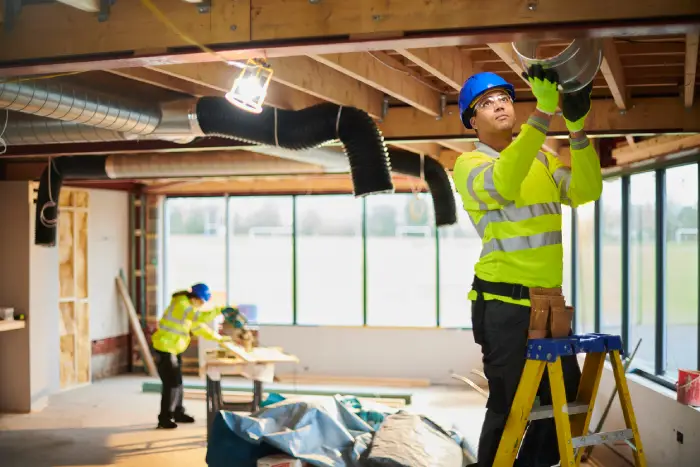
The Two Primary Types of Ductwork
Are you a property owner looking to upgrade your HVAC system’s ductwork? If so, it is imperative to understand the differences between the two primary kinds of ductwork: rigid and flexible ductwork.
Each type serves the same fundamental purpose – distributing air throughout your home at a specific, conditioned temperature. However, there are pros and cons behind each choice you should consider when making your decision over which to install in your home.
Aire Serv of Nashville understands how daunting installing new ductwork can be for homeowners. Today, we’re going explore what each type of ductwork offers. Hopefully, this information will help you enjoy the peace of mind of knowing you’ve made the right decision for your property.
What Is Flexible Ductwork?
Flexible (Alumaflex/AFC) Ductwork is typically tube-shaped and made from a steel-string wire coil covered with a flexible polymer plastic. Alumaflex is quickly becoming a preferred option for homeowners who want to insulate their homes affordably and efficiently.
It offers many benefits, including:
Durability and Reliability
One of the main advantages of using AFC is its durability and reliability. Unlike rigid metal ducts, which can rust over time, AFC ducts are designed with a flexible material that resists corrosion and won’t easily break down. You can rest assured knowing your Alumaflex ductwork will likely last for decades without needing costly repairs or replacements.
Ease of Installation
Another significant benefit of choosing AFC ducting is its ease of installation. Alumaflex ductwork offers tremendous flexibility. Because it is lightweight and flexible, it can be easily routed around obstacles, such as joists and studs, during the installation process. There’s also more leeway in terms of joints fitting imperfectly during installation. After all, Alumaflex is designed to be malleable and accommodating to tight spaces. This leniency can save time, stress, and money compared to installing rigid metal ducts (which require exact measurements and special tools).
Temperature Control
Finally, one of the most important benefits of using AFC ducting is its ability to withstand and adjust to temperature changes. The material’s flexibility allows it to adapt to temperature fluctuations. With flexible ductwork, you’re less likely to deal with mold issues caused by condensation forming inside your air conditioning unit or heater. This type of ducting also allows you to run your heater uninterrupted.
The Downsides of AFC Ductwork
Att the same time, Alumaflex’s pliability can also be a liability. Unfortunately, bends and kinks can cause the system to work inefficiently. The walls of flexible ductwork can crumple and cave in, obstructing and resisting airflow before it reaches the designated vent. As a result, it is critical to hire a contractor to arrange and configure flexible ductwork materials with expertise. Our technicians will avoid sharp turns and sagging sections that can cause flexible ductwork to collapse under its own weight.
All About Rigid Ductwork
Rigid ductwork comes in a variety of materials, including:
- Fiberboard ducts: This ductwork consists of compressed fiberglass strands bonded with resin and covered with a moisture-resistant foil laminate.
- Fiberglass-lined ducts: This material consists of sheet metal lined with fiberglass.
- Sheet metal ducts: This ductwork style is usually made from aluminum and galvanized steel.
Rigid ductwork can be cylindrical or rectangular, but it won’t fluctuate or vary like flexible ductwork. Its shape is fixed – making it reliable and durable but also more expensive than flexible materials.
Some noteworthy benefits of rigid metal ductwork include:
Longevity
Rigid metal ducts constructed from strong materials (such as galvanized or stainless steel) are an excellent choice. Like flexible aluminum, these steels are resistant to rust and corrosion – making them ideal for homes in wet or humid climates.
Low Maintenance
Rigid ducts require periodic inspections and minimal maintenance. Their sturdy construction prevents them from collapsing or deforming under pressure, so the need for repairs is rare. This general lack of upkeep saves homeowners time and money.
Quieter than Flexible Ductwork
Rigid ducting is quieter than its flexible counterpart. Due to its shape, sound waves are smoothly channeled and directed by the material. On the other hand, flexible ductwork is often noisy as its walls expand and contract due to air pressure and temperature changes. This amplified movement can sometimes reverberate through the walls.
Lower Airlow Resistance
Rigid metal ducts offer lower airflow resistance, which means less wasted energy. With more efficiency, you can reduce your power bill while saving money in the long run.
The Downsides of Rigid Ductwork
There are also some downsides associated with rigid metal ductwork. First, rigid ductwork tends to be heavier than its aluminum counterparts. Consequently, it may require additional manpower to install and added infrastructure to support its weight over time (especially if the ductwork spans long distances within your home’s walls or ceilings).
Secondly, rigid metal ductwork requires a lengthy and complex installation process not suitable for the DIY approach. It’s much wiser to hire a qualified professional to install all ductwork. At Aire Serv of Nashville, we’re ready to get the job done right. Our expert technicians know how to correctly size and install rigid metal ducting for optimal performance and efficiency!
Need New Ductwork? Contact a Pro!
When deciding which type of HVAC ducting will best fit your needs, there are many factors to consider. Each ductwork option has unique pros and cons depending on your needs. Fortunately, Aire Serv of Nashville is always available to assist.
We are eager to help you determine the ideal option for your property and budget before investing in a large-scale HVAC renovation project! Our industry-leading experience, equipment, and expertise will ensure your ductwork upgrade is seamless and flawless – from start to finish.
Have a question? Call our team today! We can help you pinpoint what ductwork material best suits your property!

